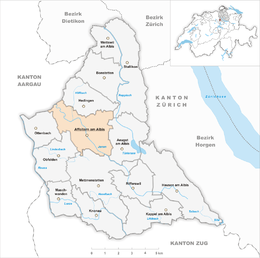Affoltern am Albis
| Affoltern am Albis | ||
|---|---|---|
 |
||
|
||
| Coordinates: 47°17′N 8°27′E / 47.283°N 8.450°ECoordinates: 47°17′N 8°27′E / 47.283°N 8.450°E | ||
| Country | Switzerland | |
| Canton | Zurich | |
| District | Affoltern | |
| Government | ||
| • Executive |
Gemeinderat with 7 members |
|
| • Mayor |
Gemeindepräsident Clemens Grötsch unrelated |
|
| • Parliament | none (Gemeindeversammlung) | |
| Area | ||
| • Total | 10.61 km2 (4.10 sq mi) | |
| Elevation (Central crossing near church) | 491 m (1,611 ft) | |
| Population (Dec 2015) | ||
| • Total | 11,695 | |
| • Density | 1,100/km2 (2,900/sq mi) | |
| Postal code | 8910 | |
| SFOS number | 0002 | |
| Localities | Zwillikon, Ferenbach, Loh, Unterdorf, Oberdorf | |
| Surrounded by | Aeugst am Albis, Hedingen, Jonen (AG), Mettmenstetten, Obfelden, Ottenbach, Stallikon | |
| Website |
www SFSO statistics |
|
Affoltern am Albis (abbreviated as Affoltern a.A.) is a statistic town and a municipality in the district of Affoltern in the canton of Zürich in Switzerland.
The official language of Affoltern is (the Swiss variety of Standard) German, but the main spoken language is the local variant of the Alemannic Swiss German dialect.
Affoltern is first mentioned in 1190 as Afiltre.
Affoltern has an area of 10.6 km2 (4.1 sq mi). Of this area, 45.7% is used for agricultural purposes, while 28.9% is forested. Of the rest of the land, 25% is settled (buildings or roads) and the remainder (0.5%) is non-productive (rivers, glaciers or mountains).
The municipality is located west of the Albis hills in the moraine landscape around the Reuss. It was created in the 19th Century through the merger of Ober- and Unteraffoltern, Zwillikon and Loo-Fehrenbach.
Affoltern has a population (as of 31 December 2015) of 11,695. As of 2007[update], 25.5% of the population was made up of foreign nationals. Over the last 10 years the population has grown at a rate of 9.8%. Most of the population (as of 2000[update]) speaks German (82.5%), with Italian being second most common ( 5.0%) and Serbo-Croatian being third ( 3.7%).
In the 2007 election the most popular party was the SVP which received 37.5% of the vote. The next three most popular parties were the SPS (17.3%), the FDP (11.4%) and the CSP (11.3%).
...
Wikipedia




